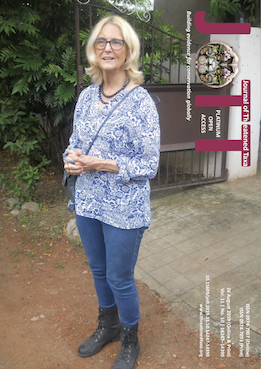Multivariate analysis of elements from the microhabitats of selected plateaus in the Western Ghats, Maharashtra, India
Main Article Content
Abstract
The Western Ghats represents a small part of the Deccan Traps continental flood basalt province that erupted about 65 million years ago. It is an area of outstanding scenic beauty and has attracted the attention of geologists, naturalists and geomorphologists for over a century. One of the unique habitats in the Western Ghats are the rocky plateaus. Previous studies have covered plant species composition, geological and geomorphological status of the rocky plateaus. An analytical study of microhabitats and associated therophytes of four rocky plateau sites was conducted. The study sites were Durgawadi Plateau, Naneghat Plateau which are basalt outcrops and Zenda plateau and Amba Plateau, which are laterite outcrops on the escarpment of the northern Western Ghats. The results revealed a correlation between basalt and lateritic rock outcrops as well as ephemeral plant elements. All four outcrops are similar in their nutrient status but the microhabitats of these plateaus are extremely different from each other.
Article Details
Authors own the copyright to the articles published in JoTT. This is indicated explicitly in each publication. The authors grant permission to the publisher Wildlife Information Liaison Development (WILD) Society to publish the article in the Journal of Threatened Taxa. The authors recognize WILD as the original publisher, and to sell hard copies of the Journal and article to any buyer. JoTT is registered under the Creative Commons Attribution 4.0 International License (CC BY), which allows authors to retain copyright ownership. Under this license the authors allow anyone to download, cite, use the data, modify, reprint, copy and distribute provided the authors and source of publication are credited through appropriate citations (e.g., Son et al. (2016). Bats (Mammalia: Chiroptera) of the southeastern Truong Son Mountains, Quang Ngai Province, Vietnam. Journal of Threatened Taxa 8(7): 8953–8969. https://doi.org/10.11609/jott.2785.8.7.8953-8969). Users of the data do not require specific permission from the authors or the publisher.
References
Bhattarai, U. (2012). Contributions of Vulnerable hydrogeomorphic habitats to endemic plant Diversity on the Kas Plateau, Western Ghats. SpringerPlus 2012 1: 1–25. https://doi.org/10.1186/2193-1801-1-25 DOI: https://doi.org/10.1186/2193-1801-1-25
Bhattarai, U., P. Tetali & S. Kelso (2012). Contributions of vulnerable hydrogeomorphic habitats to endemic plant diversity on the Kas Plateau, Western Ghats. Springer Plus 1(1): 25.
Gunnel, Y. & B.P. Radhakrishnan (2001). Sahyadri – The Great Escarpment of the Indian Subcontinent (Patterns of Landscape Development in the Western Ghats) - Vol 1 & 2. Geological society of India, 1053pp.
Hemadri, K. (1980). Grasses of Junnar and Surroundings, Poona District (Maharashtra State). Bishen Singh Mahendra Pal Singh, Dehradun, 127pp.
Lekhak, M.M. & S.R. Yadav (2012). Herbaceous vegetation of threatened high-altitude lateritic plateau ecosystems of Western Ghats, southwestern Maharashtra, India. Rheedea 22(1): 39–61.
Ollier, C.D. & H.C. Sheth (2008). The high Deccan duricrust of India and their significance for the ‘laterite’ issue. Journal of Earth System Sciences 117: 537–551.
Rahangdale, S.S. & S.R. Rahangdale (2014). Plant species composition on two rock outcrops from the northern Western Ghats, Maharashtra, India. Journal of of Threatened Taxa 6(4): 5593–5612. https://doi.org/10.11609/JoTT.o3616.5593-612 DOI: https://doi.org/10.11609/JoTT.o3616.5593-612
Porembski, S. (2000). West African Inselbergs Vegetation, pp177–211. In: Porembski, S. & W. Barthlott (Eds.). Inselbergs: Biotic Diversity of Isolated Rock Outcrops in Tropical and Temperate region. Ecological Studies 146. Springer, Berlin, Heidelberg, New York, XXXII+524pp. https://doi.org/ 10.1007/978-3-642-59773-2
Porembski, S. & A. Watve (2005). Remarks on the species composition of ephemeral flush communities on paleotropical rock outcrops. Phytocoenologia 35(2-3):, 389-402. https://doi.org/10.1127/0340-269X/2005/0035-0389 DOI: https://doi.org/10.1127/0340-269X/2005/0035-0389
Porembski, S. & W. Barthlott (2000). Granitic and gneissic outcrop (inselbergs) as centers of diversity for desiccation-tolerant vascular plants. Plant Ecology 151: 19–28.
Porembski, S., R. Seine & W. Barthlott (1997). Inselberg vegetation and the biodiversity of granite outcrops. Journal of the Royal Society of Western Australia 80: 193–199.
Sambhaji, A. D. A. K. (2015). Tree species assessment at Lohgad and Visapur Fort–a part of Western Ghats, Maharashtra (India). Indian Forester 141(5): 549–553.
Shtangeeva, I. & D. Alber (2009). Multivariate statistical analysis of nutrients and trace elements in plants and soil from northwestern Russia. Plant and Soil 322: 219–228.
Watve, A. (2007). Plant community studies on rock outcrops in northern Western Ghats. A Technical Report.
Watve, A. (2008). 21.0 Rocky Outcrops as Special Habitats in North Western Ghats, Maharashtra. Special Habitats and Threatened Plants of India 11(1): 147.
Watve, A. (2009). Rocky Outcrops as Special Habitats in North Western Ghats, Maharashtra, pp147–153. In: Rawat, G.S. (ed.). Special Habitats and Threatened Plants of India. ENVIS Bulletin: Wildlife and Protected Areas. 11. Wildlife Institute India, Dehradun.
Watve, A. (2013). Status review of Rocky plateaus in the northern Western Ghats and Konkan region of Maharashtra, India with recommendations for conservation and management. Journal of Threatened Taxa 5(5): 3935–3962. https://doi.org/10.11609/JoTT.o3372.3935-62 DOI: https://doi.org/10.11609/JoTT.o3372.3935-62
Watve, A. & S. Thakur (2006). Ecological studies on lateritic plateau habitats in northern Western Ghats, pp22–28. In: Pandey, H.N. & S.K. Barik (ed.), Ecology, Diversity and Conservation of Plants and Ecosystems in India. Regency Publications, Delhi.
Widdowson, M. & K.G. Cox (1996). Uplift and erosional history of the Deccan Traps, India: Evidence from laterites and drainage patterns of the Western Ghats and Konkan Coast. Earth and Planetary Science letters 137(1–4): 57–69. https://doi.org/10.1016/0012-821x(95)00211-t DOI: https://doi.org/10.1016/0012-821X(95)00211-T

